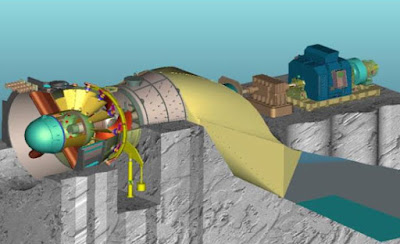Hydro Turbine S Type Turbine for Hydropower Project
S type turbine is suitable for heads from 2m to 20m and large discharge hydropower station. S-type tubular turbine is available in versions of Horizontal Kaplan, also called S-type horizontal Kaplan.
S-type tubular turbine is available in versions of Horizontal Kaplan, also called S-type horizontal Kaplan.lts feature is that the water flow is axial throughout the passage from the inlet to the outlet, so that the passage is a straight conduit essentially.The turbine shaft passes out of the tube at the point where the tube changes direction, installation is ether with the transfer belt or directly connected to the generator. This modern turbine is characterized by high efficiency in a broad band of flow rates.
S-type turbine is also consist of fixed runner blades and movable runner blades.
Rotating part consists of runner, main shaft, short main shaft, and transition flange. The rotating part is the important part of turbine; the potential energy and kinetic energy of water flow is transformed into mechanical energy, and then it is transmitted to generator shaft by main shaft and finally is converted into electric energy. Therefore, rotating part play the role of energy conversion and transmission.
Runner is the heart of turbine, and the conversion of energy is completed by runner. Therefore, it should have high efficiency, and excellent performance of cavitations erosion resistance to ensure economic and steady operation of unit; the blade of runner material is
ZG0Cr13Ni4Mo, molded line, wave steepness and surface toughness have been controlled strictly to ensure turbine in high efficiency state. runner hub material is casting ZG230-450.
Main shaft is made of 45# forged steel; Transition flange is installed between main shaft and thrust shaft; so that the runner and main shaft will be disassemble without removing thrust shaft.
 |
Kaplan turbine with adjustable blades
|
 |
| Layout drawing of S type water turbine |
































